A lightweight, airborne SPG
In this website we will see all American SPGs, beginning with those of the early cold war, like the M53 155 mm SPG. The latter was partly based with components of the M48, and existed in a 203 mm heavy artillery version. The artillery piece and servants were well protected by a turret-like superstructure but it was quite heavy, at 44 tons, but had a gasoline engine which gave reduced range and could cause possible explosion hazards. The need for a lighter SPG was made obvious and specs were laid down for an air-transportable, standardized vehicle based on existing components. Based on these, Pacific Car and Foundry presented prototypes: The 175 mm T235 and the 203 mm T236. Both had diesel engines and were successfully tested, and adopted, standardized as the M107 and M110 respectively in 1962 and 1963.Development and production
Although the M107 was also built by the FMC Corporation and Bowen-McLaughlin-York, the initial bidder was Pacific Car and Foundry, chosen by Detroit tank arsenal because of the patented key features of the M55 which were provided, like the gas equilibrator barrel balance system, and associated pendulum sensor, no back pawl limits and taper hydraulic recoil cylinders, or the hydraulic lockout of the suspensions when shooting. FMC started producing components for the chassis and the vehicle itself, and from 1965 Bowen-McLaughlin-York join in up to the end in 1980. Only 524 vehicles were built but widely exported. Due to its small size, it was almost considered as a specialized SPG but was cheap due to the commonality with the M110 howitzer (750) and other vehicles like the M578 Light Recovery Vehicle and mainstream APCs and their variants like the M113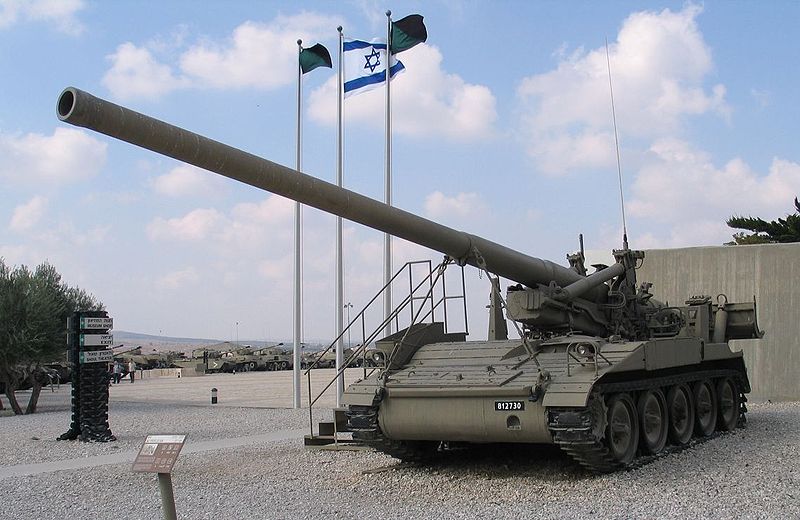
Israeli M107 at Latrun museum.
Design
The M107 was essentially similar to the M110 (see later) only differing by its main armament which traded ammo weight and caliber for range. This piece of artillery was longer (but short in early 1960s version) and without a muzzle brake. The hull was indeed quite small and light with parts from the FMC standard APCs, roadwheels, front drive sprockets, tracks, torsion bars units, but without return rollers or rear idlers. The hull was made of steel RHA, welded, prismatic at the front but with flat sides and rear. Armour thickness was minimal as the vehicle was intended to be air-transportable and be used in indirect fire from relatively secured areas.Total weight, with the engine, gun barrel, mounting and associated systems was 28 tons, but the hull itself was probably not over 12-16 tons. This vehicle was also propelled by a capable General Motors 8V71T V8 2 cycle supercharged diesel (connected by a steel pencil sized “quill” shaft) which gave 450 hp for a recorded top speed of 80 kph (50 mph), quite remarkable for the time for any SPG. This allowed this vehicle to avoid counter-battery fire while pulling itself out of harm's way with amazing facility as well as a seamless integration into the most mobile armored divisions. In addition, the diesel allowed for a generous 750 km range (450 miles). The M107 was also capable of dealing with a 60% gradient, 30% side slope, 1 m vertical step, 2.36 m trench, or ford 1 m of water. Its ground pressure was 0.82kg/cm² with a clearance of 44 cm.
Its sole and main armament consisted of a 175 mm gun with a Barrel length of 60 calibers (standard version), but reduced to 30 at the origin, which fired a projectile weighing 79 kg at a maximum firing range of 40 km (34 at the origin), maximum rate of fire or 1 rpm. The hydraulic arms and mounting provided an elevation range from - 2 to + 65 degrees, while the mounting itself has a frontal traverse arc of 60 degrees. However only two rounds were carried on "loading trays", the main supply and crew following on M548 transporters. One of the specifics of the vehicle was its rear hydraulic spades system, which allowed the vehicle's rear to dig itself in and transfer the recoil into the ground when firing, sparing stress and fatigue for components like the transmission and suspensions.
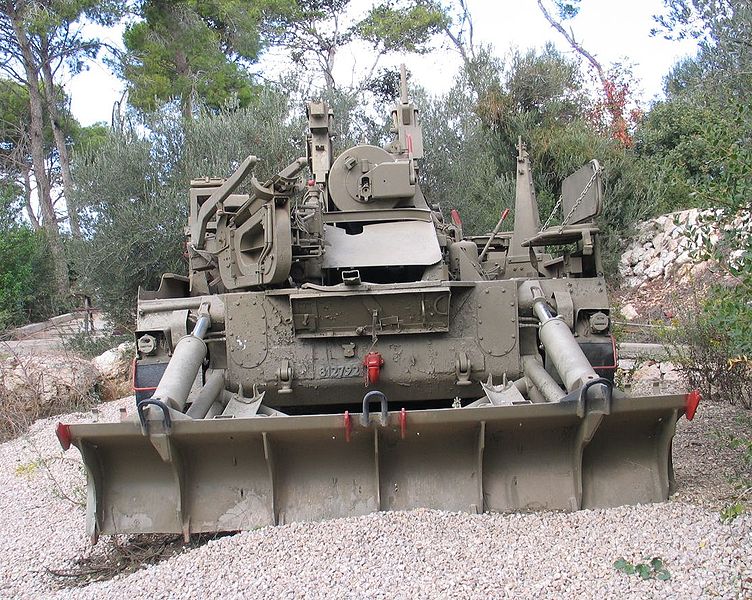
M107's rear hydraulic spades
Only one crew members took place inside the tank (out of 13): The driver located at the front-left hand side, with its own one-piece sliding hatch and three-day sights. He was also in charge of the positions spade and barrel travel lock. The gunner was in charge of the controls deflection, his assistant of elevation. The section's commander (de facto "tank commander") was in charge of the hydraulic load and ram, verifying the gunner's solution and control of the rear hydraulic spades. The number one cannoneer was in charge of the breach and ramming of the round and powder load. The other cannoneers (not part of the reduced crew), up to nine of them, were in charge of the ammo supply and preparation of the fused, charges, but also aiming stakes, and bore sight, communication, security, and run the M548 among other tasks. Bores were manufactured for a normal cycle life of 300 rounds with a zone 3 propellant, but later on, this figure was improved up to 700 and even 1200. Retubing the barrel was a task for the Ordnance Depot Support Units or fixed depots (like the Anniston Army Depot). When done on the field, including the replacement of heavy components and engine, the M578 support vehicle was in charge.
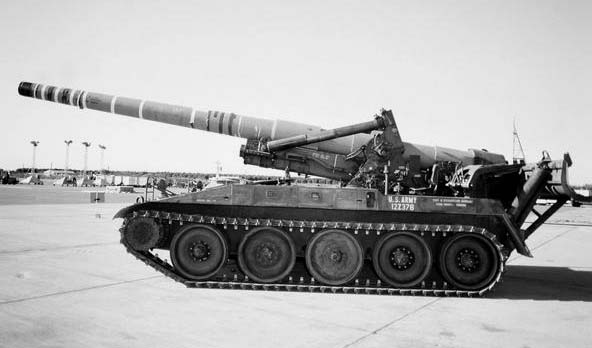
M110 Howitzer in Yuma, 1975
The M110 Self-Propelled Howitzer
Developed from the same platform both vehicle were very similar, but differing by their main armament. A 175 mm field gun in the case of the M107 and 203 mm howitzer in the case of the M110. Both models were complementary: What the M110 lacked in range and accuracy, it nevertheless beats the M107 in terms of raw firepower and was a fresh proposition after the ww2 heavy 203 mm self-propelled mounts which lacked in autonomy and speed. In all 750 were produced, declined into the A1 and A2 recently and even more exported. It is still in service in some countries despite its age (1959). Many M107s were lately converted into M110A2 SPGs.The M107 in action
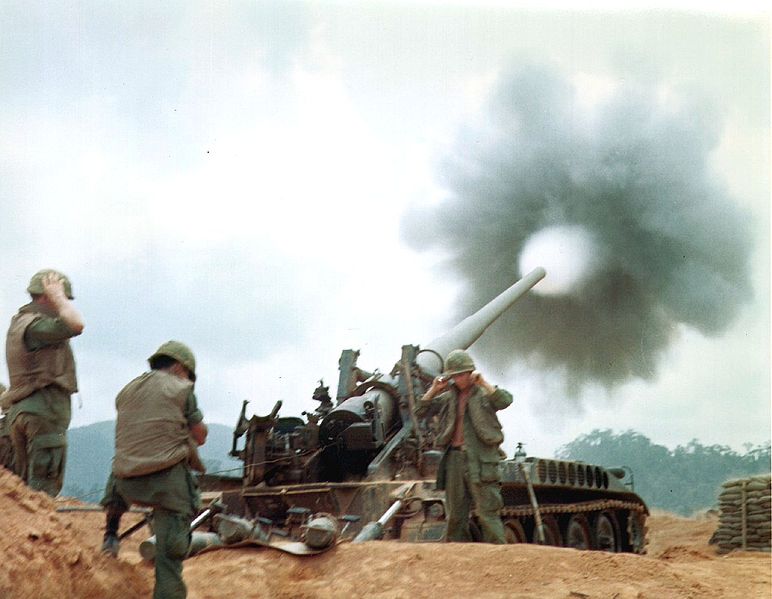
M107 firing in Vietnam 1968.
The M107 had quite a prolific career spanning decades, entering service prior the Vietnam war. Its hallmark was its excellent mobility which allowed to evade counter-battery fire and range capabilities, surpassing even the best Soviet-built artillery pieces of SPGs like the 2S7 Pion, and was employed with success by destroying command, control, communications facilities and supply trains.
It was also widely used at the end of the war by South-Vietnamese Forces and proved itself in several occasions, notably at the siege of Khe Sanh in 1968. But it also had its limitations, notably reduced accuracy at extreme range and dependency to a supply carrier. Many were lost, and some were also captured, so much so that a PAVN's Artillery Corps composed entirely of this ordnance fought long after the war, in 1970 and 1980s conflicts. The M107 were also used with profit by the IDF forces at Yom Kippur, dealing with Syrian and Egyptian anti-aircraft missile positions. It was also first line in the operation Gazelle on the other bank of the Suez canal. IDF's Romachs were later upgraded (range 50 km) by Gerald Bull's Space Research Corporation and 175 are still maintained in service.
The M107 was retired in the 1970s from the US Army arsenal, gradually replaced by the M103, but still soldiers on in many countries around the world. The list of customers includes(included) also West Germany, Greece, Italy, Spain, UK, Iran, South Korea, and Turkey.
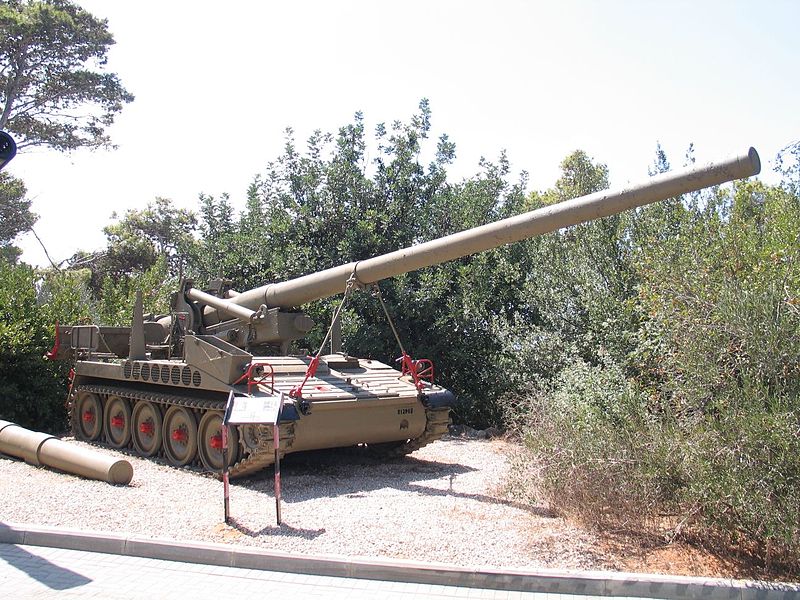 Israeli Romach (local denomination for the M107). So far 175 are in service with IDF, modernized.
Israeli Romach (local denomination for the M107). So far 175 are in service with IDF, modernized.
Links
M107 On wikipediaM107 On Military Today
M107 specifications |
|
| Dimensions | 6.46 (11.30 oa)x 3.15x 3.47m (21.2(37) x10.4 x11.5 ft) |
| Total weight, battle ready | 28.3 tons (32.400 ibs) |
| Crew | 5 (driver, cdr, gunner, ass.gunner, cannoneer) |
| Propulsion | GM 8V71T V8 supercharged diesel 450 hp |
| Suspension | Torsion bars |
| Speed (road) | 80 km/h (50 mph) |
| Range | 720 km (450 mi) |
| Armament | 175 mm M113/M113A1 Gun |
| Armor | 8 mm sides to 15 mm front (0.3-0.5 in) |
| Total production | 524 in 1962-80 |
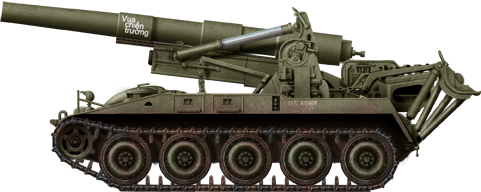
M107, Viet-Nâm 1968: Many received local nicknames like "Sấm sét" (Lightning) and "Vua chiến trường" (King of Battlefield) painted on the barrel.
 M107 long barrel (175/60), US Army 1970s.
M107 long barrel (175/60), US Army 1970s. West German M107 NATO camouflage, 1980s.
West German M107 NATO camouflage, 1980s.
Israeli Romach as of today. The bore and ammunitions were modernized, range extended to 50 km.
Gallery
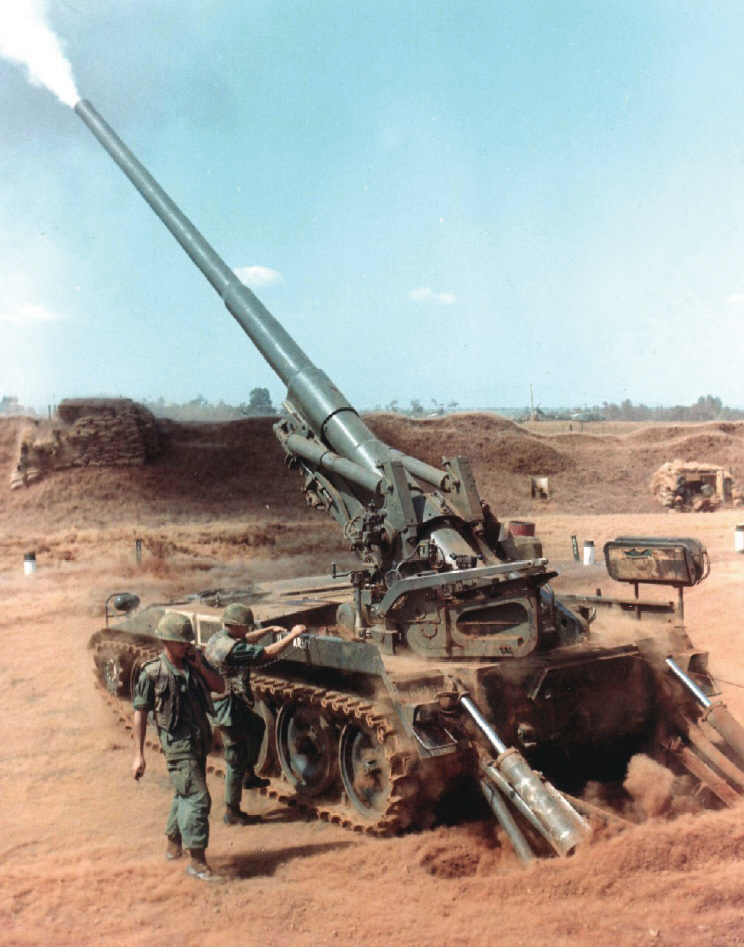 Superb photo of a M107 in action in Vietnam, 1968 or 1969.
Superb photo of a M107 in action in Vietnam, 1968 or 1969.
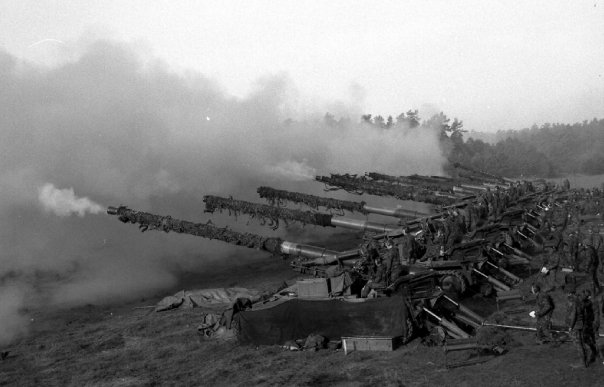 M107 British Artillery Firing in exercizes
M107 British Artillery Firing in exercizes
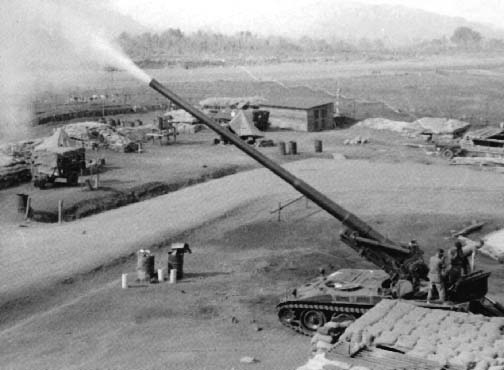 M107 175 mm in Vietnam
M107 175 mm in Vietnam
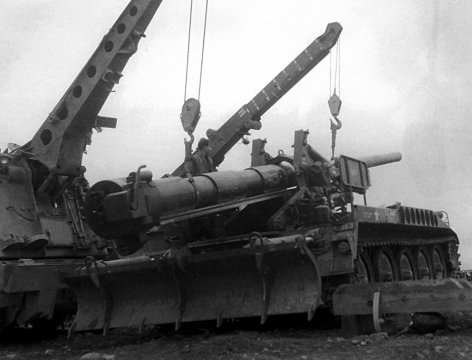 Replacing barrel on an M-107 at Camp Carroll 1968
Replacing barrel on an M-107 at Camp Carroll 1968
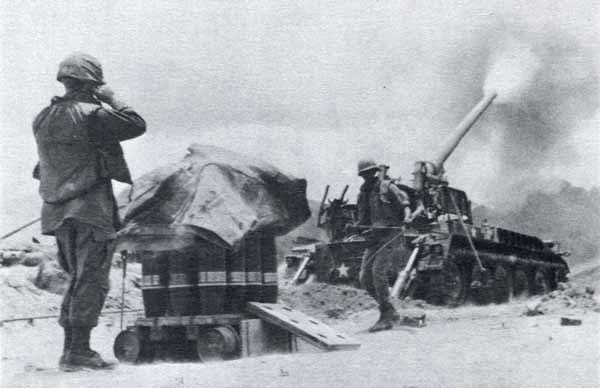 M107, 175 mm Vietnam
M107, 175 mm Vietnam
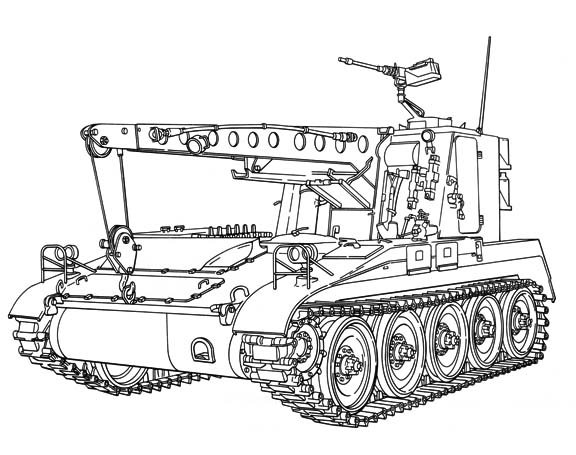 M578 drawing
M578 drawing
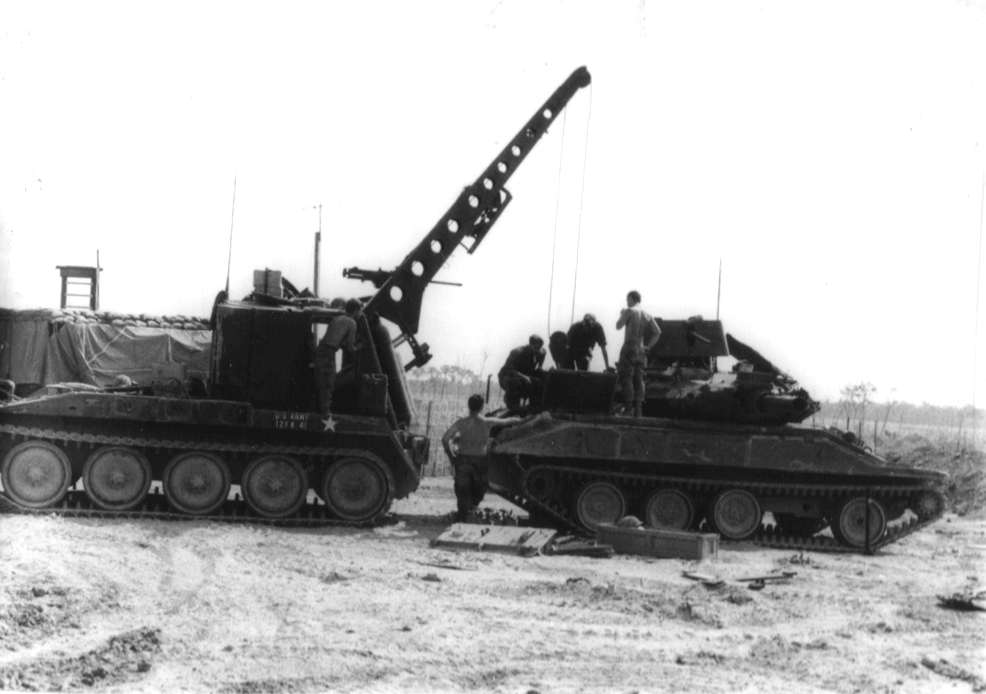 M578 Recovery Vehicle in action
M578 Recovery Vehicle in action
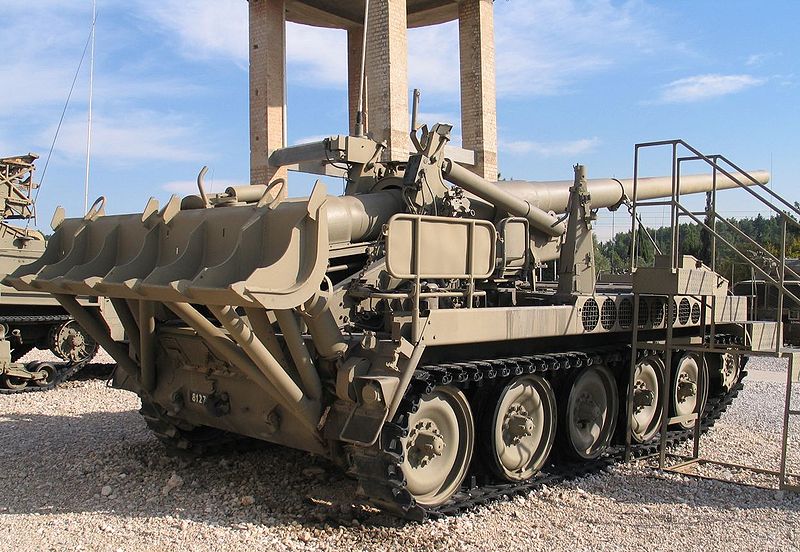
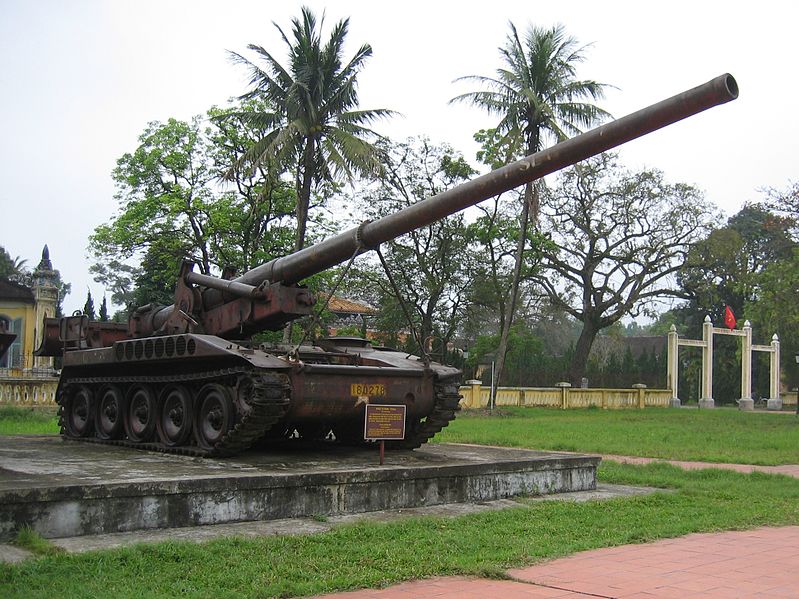

Cold War Tanks


































Cold war tanks posters

Cold War Main Battle Tanks

Cold War Soviet Army
Museums, Movies, Books & Games
The Tanks and Armor in pop culture
Tanks and armored vehicles in general are only really grasped when seen first person: The mass, the scale, it's all there. Explore also the way tanks were covered in the movie industry, in books and in video games.Movies:
Best tanks movie on warhistoryonline.com
On imdb.com
On bestsimilar.com/
miltours.com
liveabout.com/
watchmojo.com
Video Games:
pcgamesn.com
historyhit.com
levvvel.com
vg247.com/best-tank-games
mmobomb.com/
alienwarearena.com

